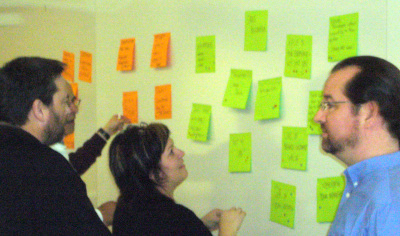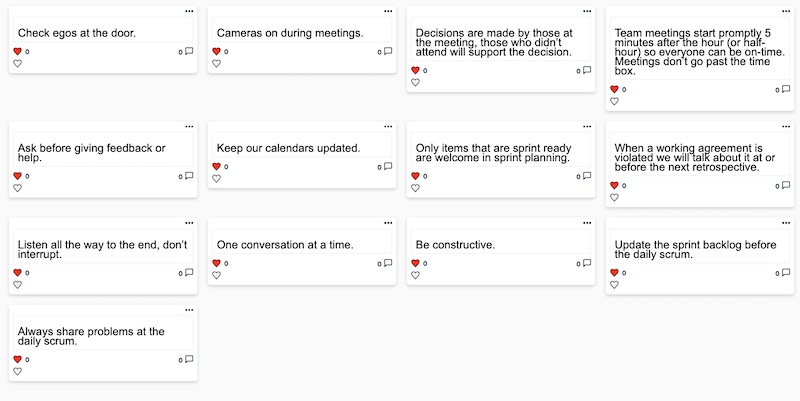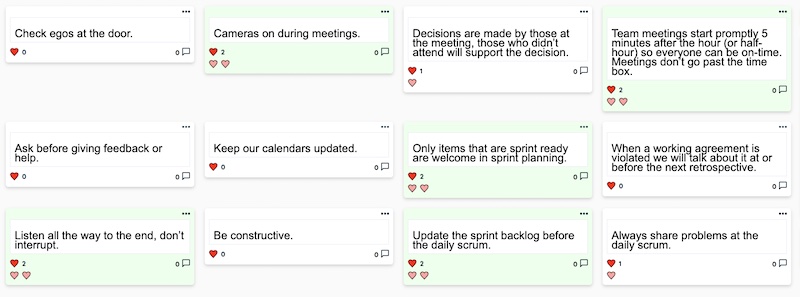 Nominal Group Technique (NGT) is a facilitation tool that helps a group quickly build a comprehensive list of ideas, issues, options or solutions, and then select the best one(s). NGT works faster than traditional brainstorming, yet generates more complete and higher quality results. NGT prevents the quieter voices from being overwhelmed and allows each participant to contribute to their full potential.
Nominal Group Technique (NGT) is a facilitation tool that helps a group quickly build a comprehensive list of ideas, issues, options or solutions, and then select the best one(s). NGT works faster than traditional brainstorming, yet generates more complete and higher quality results. NGT prevents the quieter voices from being overwhelmed and allows each participant to contribute to their full potential.
The Nominal Group Technique was developed in the 1970’s by Andre Delbecq and Andrew H. Van de Ven. The effectiveness of NGT has been validated by subsequent research.
Let’s see how NGT can be used by a scrum team to create working agreements for their scrum events and other meetings. Such agreements are often called meeting ground rules.
Roles
It is recommended to have a dedicated facilitator for the session. It might be helpful to have one or more dedicated scribes. The facilitator should be someone familiar with the NGT process; they will keep the proceedings moving along smoothly. The scribes will write down and post the ideas. Having these roles filled by non-participants will allow each of the subject matter contributors to focus their energy on the matter at hand.
In our example, the team’s scrum master, Sam, will act as facilitator. Sam recruits Sue, another scrum master at the company, to act as scribe. The whole scrum team will participate in the event.
Agenda
The agenda for creating working agreements using NGT looks like this:
- Set The Stage
- Generate Ideas
- Share Ideas
- Consolidate Ideas
- Dot Voting To Find The Best Ideas
- Rank The Ideas
- Decide
Set The Stage
Participants are briefed on the topic under consideration and the ultimate goal. There may be a short discussion period, if needed, to help everyone understand the topic and the goal.
Sam explains that the goal is for the team to create working agreements to make their meetings more effective. Sam previously sent information about working agreements to the team members so that they would be prepared. Sam gives a short presentation about the benefits of working agreements and fields any questions from the team.
Generate Ideas
This section is facilitated using parallel silent writing. Compared to open discussion, this will generate a greater variety of ideas and equalize participation from introverts and extroverts.
Provide everyone with pen and paper, or the online equivalent, so that they have a place to record their ideas. Participants are then given several minutes to silently generate their own list of ideas. The goal is to generate as many ideas, issues or options as possible, without regard to quality or feasibility.
Our scrum team is distributed, and they are meeting online to create their working agreements. Sam asks each person to create a document to capture their ideas for possible working agreements. Some team members use paper and pen. Others use text editors or word processors. Sam sets a timer for five minutes and everybody silently generates lists of possible working agreements for the team.
Share Ideas
This section is facilitated as structured rounds to allow all participants to share and all ideas to be heard.
Remind participants that all ideas are welcome, even those that don’t seem like ‘good’ ideas. Welcoming all contributions creates an environment that encourages creative thinking and experimentation, just the thing required for innovation.
Sam reviews the ground rules for idea sharing:
- Questions for clarification are allowed and encouraged
- Criticism is not allowed; all contributions are welcome
- One idea per turn
A participant is selected to share the first idea. The idea is explained and any clarification questions are answered. A short summary of the idea is posted for all to see.
The process repeats, around and around the room, with each person sharing one idea at a time. Duplicate ideas need not be shared. If a participant has no ideas left to share when it is their turn, they may pass. If they subsequently have a new idea, they may share it next time their turn comes around.
When most people have exhausted their lists, the facilitator can initiate the final round. During the final round, people with ideas raise their hands. The facilitator chooses one person at a time to share all of their remaining ideas. This repeats until no raised hands are left.

For our scrum team, Sue the scribe has been typing each proposed agreement into the online tool the team is using for the exercise. This contains ideas such as:
- We tell the truth, with compassion.
- Listen all the way to the end, don’t interrupt.
- When a working agreement is violated we will talk about it at or before the next retrospective.
- Cameras on during meetings.
- One conversation at a time.
- All meetings will have goals and agendas sent out in advance.
Consolidate Ideas
Any obvious duplicates should be discussed and consolidated. If there is significant disagreement or if the originator of an idea objects to the consolidation, then the ideas should remain separate.

Our scrum team decides that “One conversation at a time.” should be merged into “Listen all the way to the end, don’t interrupt.”
Dot Voting To Find The Best Ideas
Dot voting is an excellent facilitation technique to engage the collective wisdom of a group. When faced with a choice between a variety of options, dot voting results in a decision that will have the broadest support.
Count up the number of ideas that have been presented, then divide by 4. Each participant is given this number of sticky dots. Our scrum team generated 12 possible working agreements, so the scrum master allots 3 votes to each of the team members.
Each participant will place a dot on each of the items that they wish to vote for. The voting happens all at once, everyone voting simultaneously.

Rank The Ideas
The ideas are then rearranged into groups based on how many dots were placed on them. Our scrum team had five items with two votes each and two items with one vote. The rest of the items received no votes.
Sometimes at the end of the voting, the group will decide that two ideas can and should be combined. If further refinement is desired, the process may be repeated using only the top vote-getting ideas.

Decide
Our scrum team is happy with the results and decides to adopt the top five items as their working agreements for scrum events and other meetings.
- Cameras on during meetings.
- Listen all the way to the end, don’t interrupt.
- Only items that are sprint ready are welcome in sprint planning.
- Team meetings start promptly 5 minutes after the hour (or half-hour) so everyone can be on-time. Meetings don’t go past the time box.
- Update the sprint backlog before the daily scrum.
Additional Resources
- Nominal Group Technique on Wikipedia
- Prioritizing With Dots In A Retrospective by Esther Derby
- Dotstorming is a tool for online NGT
- 8 Ground Rules for Great Meetings
- How to Facilitate Powerful Working Agreements

I love this idea for working agreements. Do you know what tool was used for this exercise (the one with all the hearts)?
Season,
We did that with DotStorming.com.
Cheers,
Chris Sims